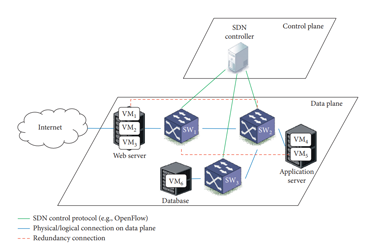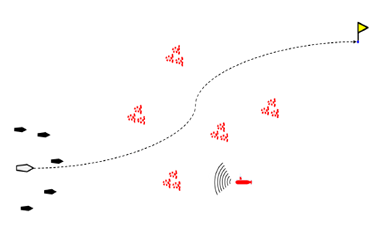연구 소개

- 연구
- 연구 소개
A Multi-Trip Vehicle Routing Problem for Small Unmanned Aircraft Systems-Based Urban Delivery
- AI융합대학
- 2019-11-06
최영훈 교수의 IASL 연구실에서 발표한 논문 "A Multi-Trip Vehicle Routing Problem for Small Unmanned Aircraft Systems-Based Urban Delivery"가 "Journal of Aircraft 2019 (JA 2019)"에 게재되었다.

[그림 1] 도심항공네트워크 생성을 위한 프레임 워크
최영훈 교수의 IASL 연구실에서는 다개체 무인기를 활용하는 다양한 시나리오에 대한 임무 및 경로 계획 최적화에 관한 연구를 진행하고 있다. Journal of Aircraft에 실린 “A Multi-Trip Vehicle Routing Problem for Small Unmanned Aircraft Systems-Based Urban Delivery” 연구에서는 3차원 point cloud data를 활용하여 3차원 도시모델을 생성하고 이를 기반으로 항공 네트워크를 형성하는 프레임워크를 제안하였다. 또한 생성한 항공 네트워크를 활용하여 다양한 드론 배송 시나리오를 graph theory와 linear programming을 바탕으로 수학적인 모델링(정식화)를 통하여 비교 분석한 결과를 제시하였다.
-
A Framework for Real-Time Intrusion Response in Software Defined Networking Using Precomputed Graphical Security Models
엄태훈 교수의 연구실에서 발표한 논문 "A Framework for Real-Time Intrusion Response in Software Defined Networking Using Precomputed Graphical Security Models"이 "Security and Communication Networks (SCN)" 2020년 호에 게재되었다.
2020-02-18
논문 사이트로 이동
[Figure 1] Framework for real-time intrusion response in SDN
Software Defined Networking (SDN) has been adopted in many application domains, as it provides functionalities to dynamically control the network flow, more robust, and more economical compared to the traditional networks. In order to strengthen the security of the SDN against cyber attacks, many security solutions have been proposed. However, those solutions need to be compared in order to optimize the security of the SDN. To assess and evaluate the security of the SDN systematically, one can use graphical security models (e.g., Attack Graphs and Attack Trees). However, it is difficult to provide defense against an attack in real time due to their high computational complexity. In this paper, we propose a real-time intrusion response in SDN using precomputation to estimate the likelihood of future attack paths from an ongoing attack. We also take into account various SDN components to conduct a security assessment, which were not available when addressing only the components of an existing network. Our experimental analysis shows that we are able to estimate possible attack paths of an ongoing attack to mitigate it in real-time, as well as showing the security metrics that depend on the flow table corresponding to the attack considering the SDN component . Hence, the proposed approach can be used to provide effective real-time mitigation solutions for securing SDN.
-
Design of Warship Simulation Using Variable-Chromosome Genetic Algorithm
지승도 교수의 지능 시스템 연구실에서 발표한 논문 "Design of Warship Simulation Using Variable-Chromosome Genetic Algorithm"이 "Multi-Agent Systems" 2020년도 특집호에 게재되었다.
2019-10-02
논문 사이트로 이동
A genetic algorithm (GA) is a global search algorithm based on biological genetics. GAs are generally used for industrial applications, artificial neural networks, web applications, the defense industry, and so on. However, it is difficult to apply GAs to more complex situations because of the fixed number of chromosomes. In this research, in order to overcome this limitation, we propose a variable-chromosome GA with a chromosome attachment feature. Verification of the algorithm is carried out through anti-submarine high value unit (HVU) escort mission simulations. Ultimately, it is confirmed that the GA using the variable chromosome is more effective in dealing with highly complex missions, whereby the number of chromosomes gradually increases.
[Figure 1] Overall methodology
the chromosomes organized by genes. These chromosomes, which are loaded on each model, are composed of 10 random chromosomes for the first generation. There are 10 chromosomes in an individual for the first generation, however, more or less than 10 chromosomes can be implemented via attachment after some generations have passed. Accordingly, it is possible to achieve flexible evolution, as the number of chromosomes is increased or decreased as necessary.
[Figure 2] Mission scenario
To validate the proposed methodology, wetested an anti-submarineHVUescort mission simulation. A submarine has firepower that is almost equal to a fleet. Thus, there are many warships that are required to cope with submarines. In this case study, we allocate warships, an HVU, helicopters, false targets, and an enemy submarine to create a complex warfare environment, as shown in Figure above The false targets are allocated randomly in every simulation, however, the warships, HVU, helicopters, and enemy submarine are allocated at fixed positions.
